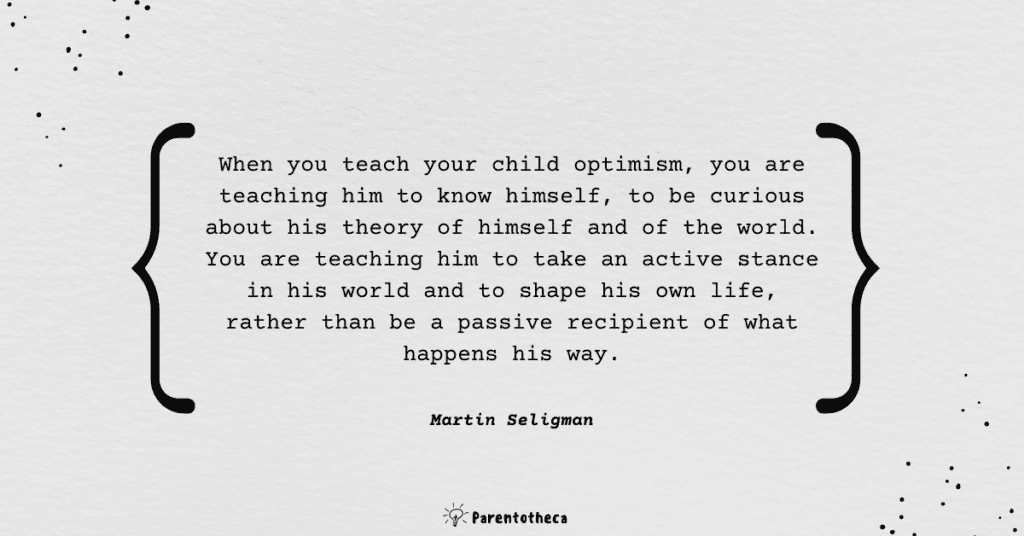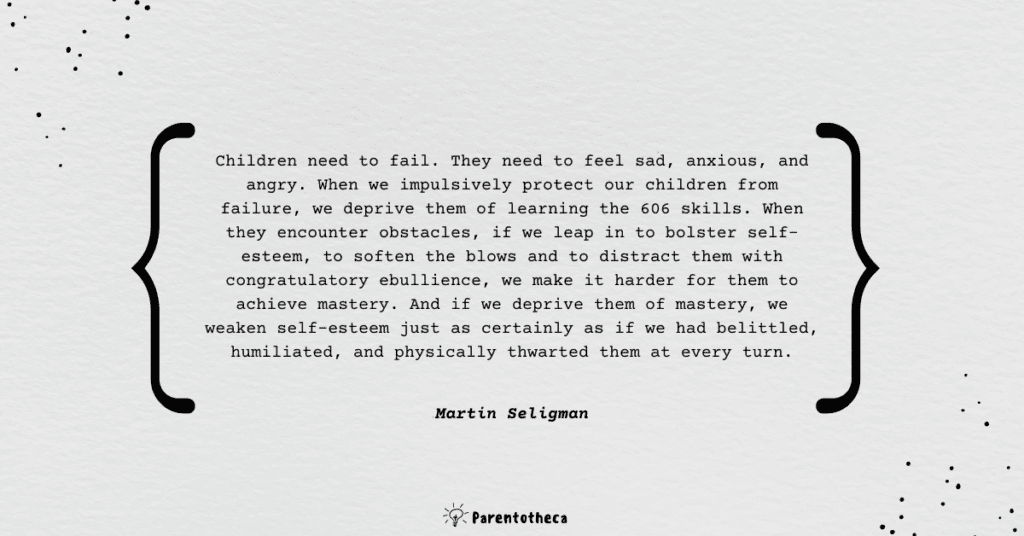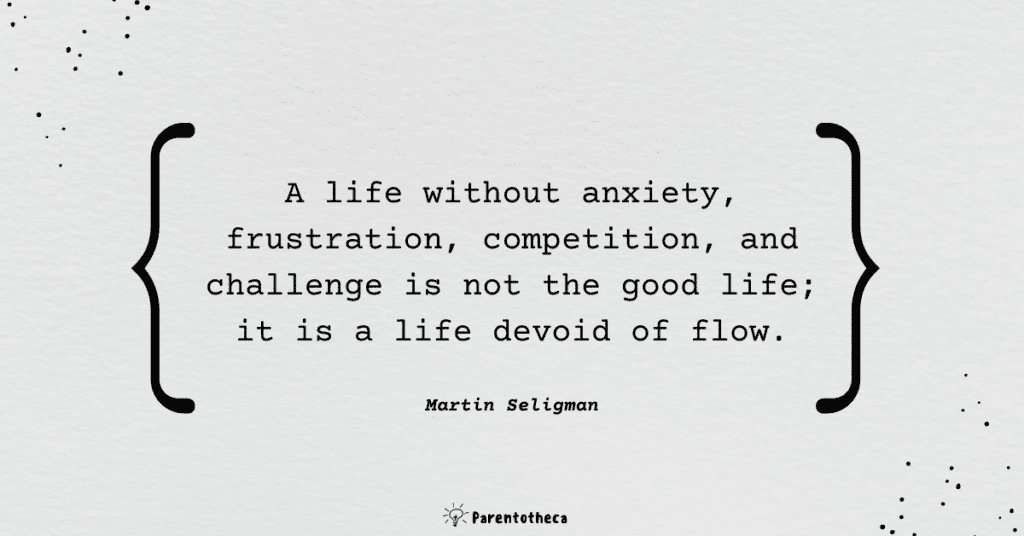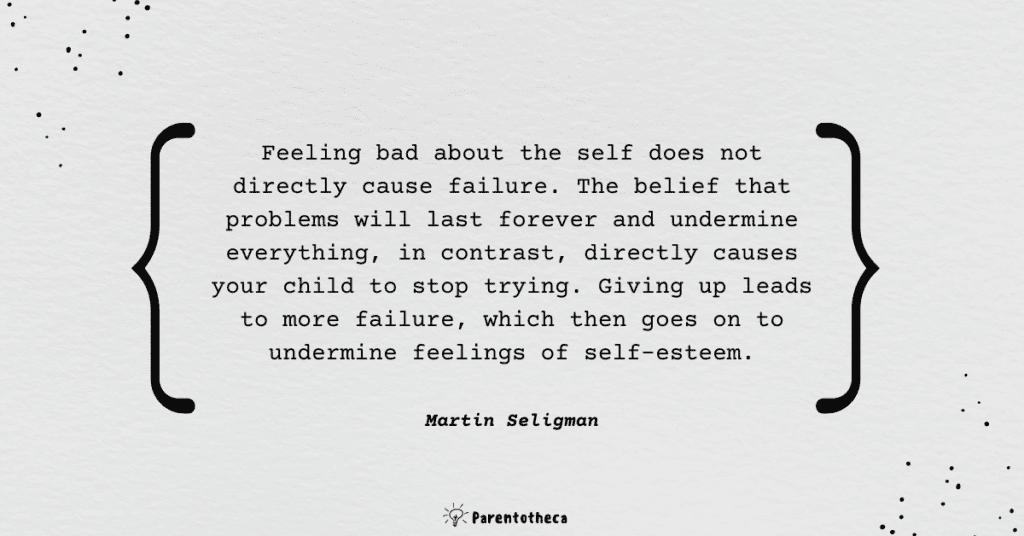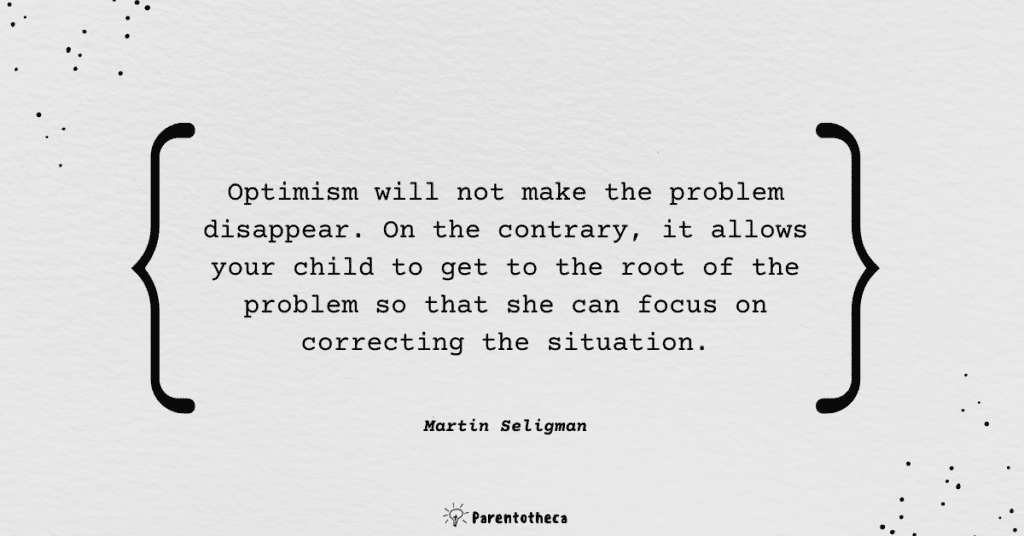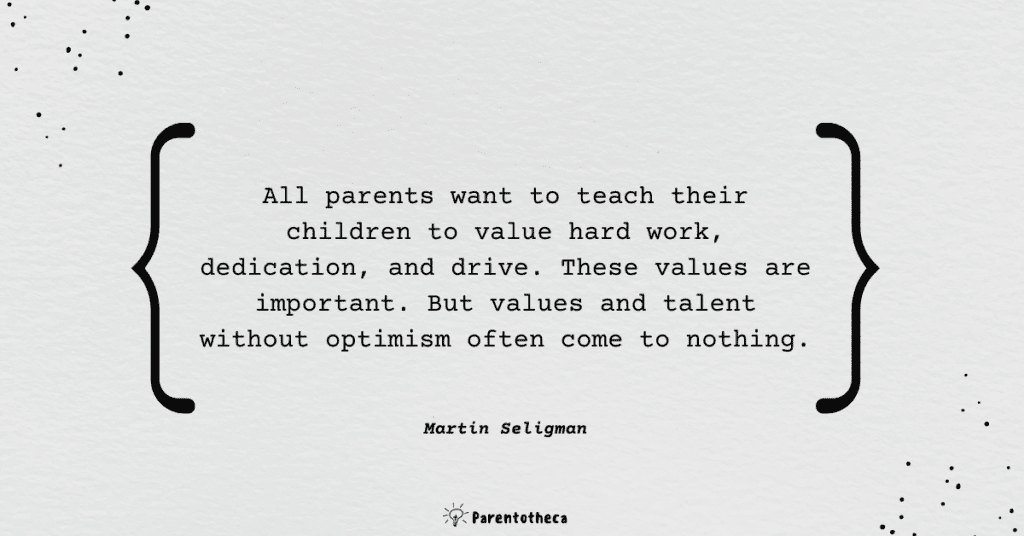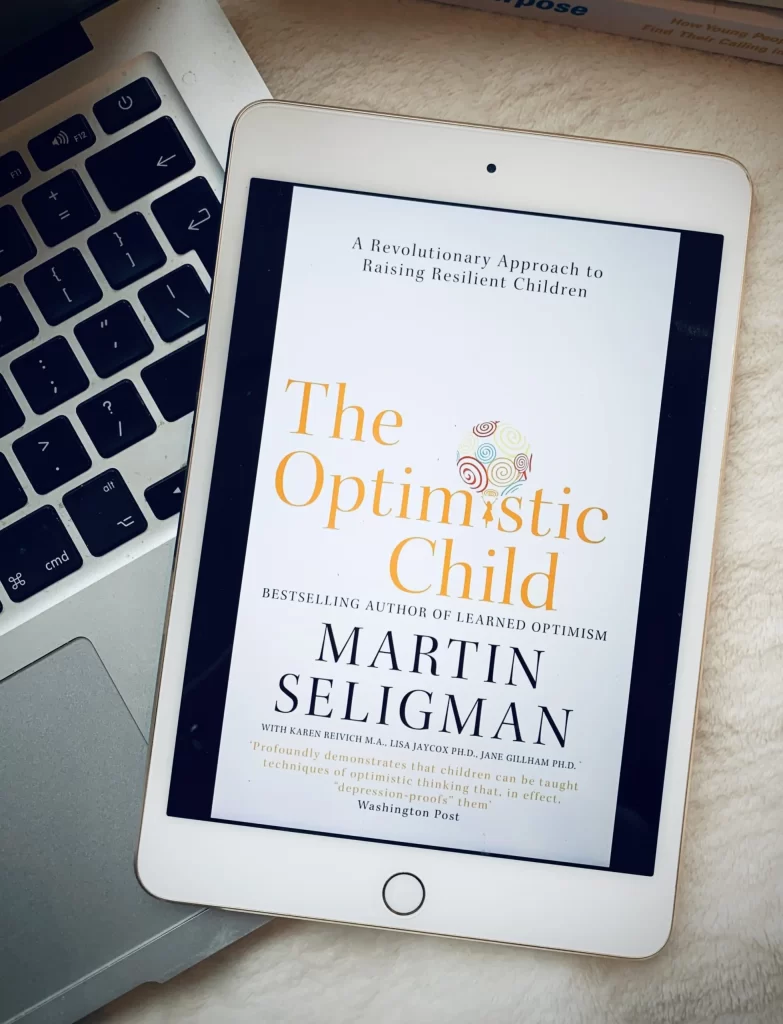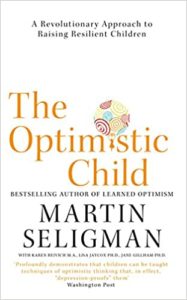 The Optimistic Child. Book Summary.
The Optimistic Child. Book Summary.
A Revolutionary Approach to Raising Resilient Children
Martin Seligman
Nicholas Brealey Publishing (19 April 2018)
About the author
Martin Seligman, Ph.D, is the father of Positive Psychology movement. His work in Positive Psychology has been supported by the National Institute of Mental Health, the National Science Foundation, the Rover Wood Johnson Foundation, Atlantic Philanthropies, and the MacArthur Foundation. He is author of the bestseller Authentic Happiness, Learned Optimism, Flourish among others. Seligman is the Zellerbach Family Professor of Psychology at the University of Pennsylvania and lives near Philadelphia with his family.
About the book:
“We can teach our children the skills of a flexible and reality-based optimism. In telling the story of a program proven to prevent depression and pessimism in children, I will give you — parents, teachers, and coaches — a practical, concrete plan of action. At stake is nothing less than the future of your own offspring and the very existence of the next generation of children, that they might be clear-eyed, forward-looking, and confident.”
If you are looking for evidence-based parenting advice on raising confident, resilient and responsible children – this book is for you. Martin Seligman is one of the leading world psychologists. He has spent decades studying optimism, learned helplessness and the science of well-being in general (check out our notes on his super insightful book Flourish).
In this book, Seligman offers us a well-validated program to “immunise” children against depression, anxiety and other mental problems. He shares practical tools we can use to master the skills of optimism ourselves and explains how we can teach children these skills, so they will be well-equipped to combat sadness, achieve more in all areas of their lives and improve their physical health.
The book is packed with great ideas, so let’s jump straight in.
Key insights:
What is optimism, where does it come from, and why does it matter
“The basis of optimism does not lie in positive phrases or images of victory, but in the way you think about causes. Each of us has habits of thinking about causes, a personality trait I call “explanatory style.” Explanatory style develops in childhood and, without explicit intervention, is lifelong. There are three crucial dimensions that your child always uses to explain why any particular good or bad event happens to him: permanence, pervasiveness, and personalisation.”
Probably, we all know that optimists see the glass as half-full while pessimists see it as half-empty. In fact, optimism is not only about positive thinking but mostly about what we say to ourselves in case of a setback. And where you stand on the optimism-pessimism spectrum has a profound influence on your life and your mental health.
Here is a table summarising the differences between pessimists and optimists when bad even happens to them:
|
Pessimist |
Optimist |
|
| Permanence | Believes that cause is permanent:
“I failed because I’m stupid” |
Believes that cause is temporary:
“I failed because I didn’t study hard” |
| Pervasiveness | Global explanations of failures:
“Teachers are unfair” |
Specific explanations of failures:
“Mrs Smith is unfair” |
| Personalisation | General self-blame:
“I got C on the test because I’m stupid” |
Behavioural self-blame:
“I got C on the test because I didn’t study hard enough” |
As you can guess, there are far more benefits of being an optimist rather than a pessimist in life:
“The depressive’s habit of thinking that the future is bleak, the present unbearable, the past filled with defeat, and the self without the ability to improve matters creates the low mood, the lack of zest, and the somatic symptoms of depression.”
Pessimism = poor mental health (and physical health too, btw) and learned helplessness. Optimism = growth mindset, grit, resilience.
One important point Seligman highlights in the book is that sometimes it’s tough for parents to recognise symptoms of depression in children. So there is a risk that they will not be able to support a child when he is having a hard time. Depression leads to behavioural problems, creates toxic stress and impedes cognitive abilities. In short, it isn’t good for kids. But Seligman believes that optimism can immunise children against mental illness and protect them from depression and low achievement.
Before moving to teaching kids an optimistic mindset, we need to understand where pessimism comes from. Seligman argues that there are four factors affecting children’s mindset: (1) Genetics, (2) Parental pessimism, (3) Pessimistic criticism from parents, teachers, or coaches, (4) Mastery and helplessness experiences.
The whole point is that our role as parents is to prevent our children from absorbing pessimistic outlooks and help them develop optimism to strive in life. How? While you can’t change genetics, you can still “change your own pessimism, you can change the way you criticise your child, you can provide mastery experiences for your children at just the right time, and you can teach your child the skills of optimism directly.”
What you know about self-esteem is probably wrong
“Feelings of self-esteem in particular, and happiness in general, develop as side effects — of mastering challenges, working successfully, overcoming frustration and boredom, and winning. The feeling of self-esteem is a byproduct of doing well. Once a child’s self-esteem is in place, it kindles further success. Tasks flow more seamlessly, troubles bounce off, and other children seem more receptive.”
Self-esteem is a big topic in psychology, and it is often misinterpreted. Most people believe that self-esteem is about how children FEEL about themselves. But the feelings are just one side of it. What really boosts children’s self-esteem is what they DO.
That’s exactly what Nathaniel Branden writes in his brilliant book The Six Pillars of Self-Esteem:
“What determines the level of self-esteem is what the individual does.”
If we do well, our self-esteem is high. It arises from mastery, persistence, meeting challenges, overcoming boredom and frustration, and working successfully.
So if we want to help children develop high self-esteem, we should stop focusing on making them feel better and concentrate on teaching them skills to DO better, especially when they are facing a hard time. And teaching kids optimism is all about that: changing child’s thinking about failure, encouraging frustration tolerance, and rewarding persistence rather than mere success.
Mastery and optimism
“Every subfailure, as well as every big failure, produces bad feeling — some admixture of anxiety, sadness, and anger. These emotions, when moderate, are galvanising, but they are also daunting. Your child has one of only two tactics available when he feels bad. He can stay in the situation and act, trying to terminate the emotion by changing the situation. Or he can give up and leave the situation. This tactic also terminates the emotion by removing the situation altogether. The first tactic I call mastery, the second I call learned helplessness. In order for your child to experience mastery, it is necessary for him to fail, to feel bad, and to try again repeatedly until success occurs. None of these steps can be circumvented. Failure and feeling bad are necessary building blocks for ultimate success and feeling good.”
That is so brilliant. We need all these bad feelings to have a fulfilled life. Anxiety, frustration, competition, and challenge help us get out of our comfort zone and grow. Without it, we can’t experience FLOW. Mastery comes from failures. But we need optimism to approach these setbacks with the right mindset (growth mindset, of course). That’s one of the most important lessons we need to teach our children.
Sometimes watching your struggling child is heartbreaking. So it’s helpful to remember Hal Runkel’s wisdom from Screamfree parenting:
“I am not responsible for my child and the choices she makes; I am responsible to my child for how I behave, regardless of her choices.”
And here is what we need to say to our children every day (from The Thriving Child by William Stixrud and Ned Johnson):
“I have confidence in your ability to make informed decisions about your own life and to learn from your mistakes.”
The good thing is that you don’t have to wait for your child to grow up to start developing mastery. Young kids can do it too! How can you support? By offering toys that provide a sense of control to your child, encouraging free play and exploration, giving them choices, and letting them make their own decisions. In a nutshell, helping them develop a sense of control.
The right way to criticise your child
“If you criticise your child as being lazy, rather than as not trying hard enough today, your child will believe not only that he is lazy, but that his failures come from permanent and unchangeable factors. Also, children listen closely to the way parents interpret their own misfortunes and model their style. If you are a pessimist, your child is learning pessimism directly from you.”
That is so important. Words matter. When we criticise our child (or ourselves), we are shaping his explanatory style about self-blame. If we go too hard on blame, a child will feel guilt and shame beyond what if necessary to galvanise him to change. That’s why pure criticism is futile.
So next time you need to deliver constructive feedback to your child, do it with an optimistic explanatory style. Here is how:
“Any time you find your child to be at fault, it is important to focus on specific and temporary personal causes, if truth allows, and avoid blaming the child’s character or ability.”
For example: instead of “I asked you to pick up your toys. Why don’t you ever do what I ask?”, say: “I asked you to pick up toys. Why didn’t you do what I asked?”. Or instead of “He never likes to play with the other kids. He is so shy”, try: “He has a hard time joining groups of kids”.
How to teach optimism to your child
“In order for you to teach your child the cognitive skills of optimism, you must first incorporate them into your own way of thinking. Children learn their pessimism, in part, from their parents and teachers, so it is very important that you model optimism for your children as a first step.”
In his studies, Seligman found a strong correlation between a mum’s optimism or pessimism and her children’s. He doesn’t mention dads, though. ☺ But I guess it’s the same.
Modelling optimism is especially important for younger children, who are not yet ready to practice cognitive skills but absorb everything they see as sponges. Before we start teaching optimism to our kids, we need to become optimists ourselves.
In the book, Seligman offers tools from his scientifically proven program, “The Penn Prevention Program”, for both parents and children. It consists of the cognitive (capturing automatic thoughts and evaluating their accuracy) and social problem-solving (handling interpersonal conflicts and solving social problems) parts. The best thing about these tools is that they help children build skills that they can use throughout their whole lives.
Here are the tools in a nutshell.
Four basic skills of optimism – ABCDE model
“Now I’d like you to practice catching your own beliefs. The best way to do this is to keep an ABC diary. For the next three days, whenever you find yourself confused or surprised by your reaction in a situation, record the adversity on a piece of paper. That evening, take five minutes to fill out your ABC diary for the day using those adversities. An “adversity” can be almost anything – a car that won’t start, a phone call that goes unreturned, a toddler who won’t nap.”
As Darren Hardy noted in The Compound effect, if we want to change our habits, we need to start tracking them. Same idea here – if we’re going to change our pessimism, we need to start tracking it.
That skill Seligman calls “Thought Catching”, and you can use the ABC model for it:
- A – Adversity (describe the facts of the situation, record “who”, “what”, “when” and “where”)
- B – Beliefs (record how you’ve interpreted the adversity – write down your feelings and thoughts)
- C – Consequences (record each feeling you experienced after the adversity or anything you did in reaction to adversity. Record the intensity of each feeling from 0-100)
Once we’ve figured this out, you can start practising detecting and changing your explanatory style. Go back to your ABC journal and label the beliefs according to the three dimensions of explanatory style: permanence, pervasiveness, and personalisation.
Then tackle the accuracy of your beliefs. Reflect on the beliefs (in your B part from the above exercise) and think critically. It’s important to take responsibility for adversity when appropriate without blaming yourself for the things that were not your fault. That’s kind of a “lessons learnt” session.
The third step is disputing. Seligman writes:
“Although most adults and children are naturally skilled disputers when accused by someone else, we are poor disputers when we are our own accusers. We know that others’ opinions of us can be biased and wrong, yet we treat our own opinions of ourselves as indisputable. Self-disputing is a lasting and effective way to challenge the validity of your unrealistic interpretations. You expose the inaccuracy of your beliefs and you prove to yourself that your beliefs are exaggerated or even plainly false.”
So here comes two more letters to the ABC model: D for disputation (your argument to counter your beliefs) and E for energisation (emotional and behavioural consequences of your disputation).
Effective disputation depends on four things:
- evidence gathering (What is the evidence for this belief? What evidence counts against this belief?)
- generating alternatives (What are other ways of viewing this adversity?)
- decatastrophizing (accurately evaluating the implications – “what if’s” of the adversity. What is the worst possible thing that could happen? How likely is this? If it were to happen, what could you do to improve the situation? What is the best possible thing that could happen?),
- developing a plan of attack (Is there anything you can do to facilitate the best case coming out? What specific actions can you take to improve the situation? How can you correct the mistake? Or soften the parts of your character that create problems for you? Or control the damage that has occurred?)
In the book, Seligman shares great tools and exercises – they are invaluable. Even though I always thought that I’m an optimist in general, after reading the book, I feel like I have huge room for improvement ☺ I’ve highlighted and bookmarked A LOT in this part of the book. So definitely get the book if you are serious about learning optimism.
Once you’ve mastered a skill, teach it to your child. It’s all about practice, practice, practice. Seligman says that this program is more suitable for older children (the exercises he offers are mostly for 8-13-year-olds and adolescents), but if your kids are still very young (like ours) – focus on your own optimism skills and model them daily.
Five steps of problem-solving and social skills
If we want our child to thrive in life, we need to teach him problem-solving skills. The key here is not to jump in and solve problems for our child (giving a fish) but to equip him with practical skills to do it effectively himself (giving a fishing rod).
Seligman highlights five steps to effective problem solving:
- Slowing down (teaching a child to stop himself from acting impulsively: distinguishing “hot” and “cold” thoughts)
- Perspective taking (understanding what the other person is thinking or why he behaved the way he did)
- Goal setting (what would you like to have happened? Set a goal and list the things you could do to reach that goal)
- Choosing a path (deciding which path offers the best solution to the problem, so you can reach your goal – outlining all the pluses, minuses and long-term consequences of each path)
- How did it go? (check if it worked – if the solution didn’t work, try another one)
However, no matter how good your child is at problem-solving, he would not be able to put his solution into practice effectively without assertiveness. And that’s one of the pillars of self-esteem – as Nathaniel Branden puts it:
“Self-assertiveness means the willingness to stand up for myself, to be who I am openly, to treat myself with respect in all human encounters.”
Four steps for teaching assertiveness:
- Describe the situation.
- Tell how you felt.
- Tell what you want other person to change.
- Tell how this change would make you feel.
Even if your child nailed assertiveness, he might still face situations when other person does not think that his ideas are right or has a different goal in mind. Therefore, it’s crucial to teach negotiation skills as well. Key steps here:
- Figure out what you want, as long as it is reasonable.
- Ask for it.
- Listen to what other person wants.
- Compromise.
- If can’t reach an agreement, make another offer.
Action steps for you:
- Revise the way you criticise your child – next time you need to deliver constructive feedback to your child, do it with an optimistic explanatory style.
- Encourage mastery – offer toys that provide a sense of control, encourage free play and exploration, give your child choices, let him make his own decisions, let him fail.
- Practice four basic skills of optimism – ABCDE diary can be an excellent journaling exercise!
Quotes from the Book:
